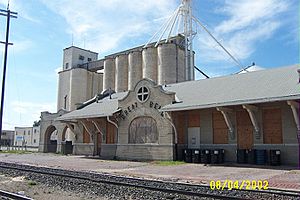Great Bend, Kansas facts for kids
Quick facts for kids
Great Bend, Kansas
|
|
|---|---|
|
City and County seat
|
|
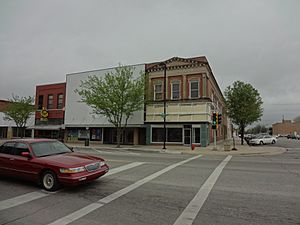
Downtown Great Bend (2012)
|
|
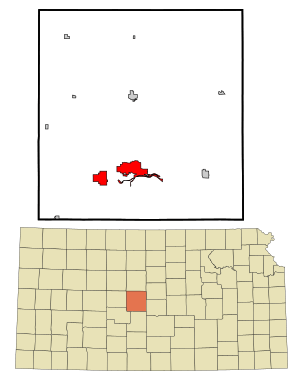
Location within Barton County and Kansas
|
|
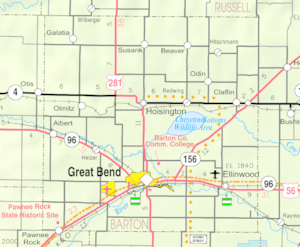
|
|
| Country | United States |
| State | Kansas |
| County | Barton |
| Founded | 1871 |
| Incorporated | 1872 |
| Named for | Bend in Arkansas River |
| Area | |
| • Total | 10.63 sq mi (27.54 km2) |
| • Land | 10.50 sq mi (27.19 km2) |
| • Water | 0.13 sq mi (0.35 km2) |
| Elevation | 1,850 ft (560 m) |
| Population
(2020)
|
|
| • Total | 14,733 |
| • Density | 1,386.0/sq mi (534.97/km2) |
| Time zone | UTC-6 (CST) |
| • Summer (DST) | UTC-5 (CDT) |
| ZIP code |
67530
|
| Area code | 620 |
| FIPS code | 20-28300 |
| GNIS ID | 475650 |
Great Bend is a city in Kansas, United States. It's the main city and county seat of Barton County, Kansas. The city gets its name because it's located where the Arkansas River makes a big bend, turning from east to southeast.
In 2020, about 14,733 people lived in Great Bend. It's also home to Barton Community College, where students can get a two-year degree.
Contents
History of Great Bend
Great Bend's story began long ago. Before American settlers arrived, the area was part of Kiowa Native American land. Later, it became part of the United States after the Louisiana Purchase in 1803. Kansas became a state in 1861.
Early Settlement and Growth
The first settlers came to this area in 1870. They lived in simple homes made of sod (grass and soil) or dugouts. At first, they hunted buffalo because the large herds made it hard to grow crops.
In 1871, a group called the Great Bend Town Company started the town. They knew the Atchison, Topeka and Santa Fe Railroad was coming west. They picked a spot near Fort Zarah on the Santa Fe Trail. The town was named "Great Bend" because of the big bend in the Arkansas River nearby. More settlers arrived, and businesses started to open.
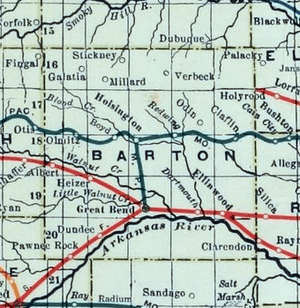
The railroad reached Great Bend in July 1872. Around the same time, Great Bend was chosen as the permanent county seat. The city was officially formed soon after. The first courthouse and public school were built the next year.
Cattle and Oil Industries
When the railroad arrived, Great Bend became a busy place for shipping cattle in 1873. This brought a lot of business but also made the town a bit wild. To make things safer, a law was passed in 1876 that moved the cattle trade further west. This helped Great Bend become more peaceful.
Over the next few decades, Great Bend continued to grow. It became an important center for trade in the area. Even after a big fire in 1878 and a smallpox outbreak in 1882, the city kept developing.
In 1886, people in the area started looking for petroleum (oil). By 1930, the oil and gas industry was bringing in a lot of money. Thousands of oil wells were producing oil in the 1930s. Many workers moved to the city, and its population grew a lot.
World War II and Modern Times
During World War II, the United States Army Air Forces opened Great Bend Army Airfield in 1943. This base was used to train pilots for B-29 Superfortress bomber planes. After the war, the city took over the base and turned it into Great Bend Municipal Airport for civilian use.
The city kept growing through the 1950s, reaching its largest population in 1960. In 1973, the Fuller Brush Company moved its factories to Great Bend, becoming a major employer. Even though the population has slightly decreased recently, Great Bend remains an important business center for central Kansas.
Geography and Climate
Great Bend is located where U.S. Route 281 and U.S. Route 56 highways meet in Kansas. It's about 116 miles (187 km) northwest of Wichita.
The city is in the Great Bend Sand Prairie region of the Great Plains. It sits on the north side of the Arkansas River, right where the river changes direction. A stream called Dry Walnut Creek flows along the northern edge of the city. A large wetland area called Cheyenne Bottoms is about 6 miles (10 km) northeast.
The city covers about 10.71 square miles (27.74 km2). Most of this is land, with a small amount of water.
Climate in Great Bend
Great Bend has hot summers and cold, dry winters. The highest temperature ever recorded was 111 °F (44 °C) in July 1954 and June/July 1980. The coldest temperature was -21 °F (-29 °C) in December 1989.
Temperatures reach or go above 90 °F (32 °C) about 70 days a year. They reach or go above 100 °F (38 °C) about 12 days a year. The temperature drops below freezing (32 °F or 0 °C) about 120 days a year.
| Climate data for Great Bend, Kansas, 1991–2020 normals, extremes 1948–present | |||||||||||||
|---|---|---|---|---|---|---|---|---|---|---|---|---|---|
| Month | Jan | Feb | Mar | Apr | May | Jun | Jul | Aug | Sep | Oct | Nov | Dec | Year |
| Record high °F (°C) | 79 (26) |
88 (31) |
93 (34) |
101 (38) |
102 (39) |
111 (44) |
111 (44) |
110 (43) |
106 (41) |
98 (37) |
80 (27) |
79 (26) |
111 (44) |
| Mean maximum °F (°C) | 66.0 (18.9) |
72.9 (22.7) |
80.7 (27.1) |
88.3 (31.3) |
92.7 (33.7) |
98.8 (37.1) |
102.7 (39.3) |
100.8 (38.2) |
97.1 (36.2) |
89.3 (31.8) |
76.2 (24.6) |
65.6 (18.7) |
103.9 (39.9) |
| Mean daily maximum °F (°C) | 42.5 (5.8) |
47.0 (8.3) |
57.7 (14.3) |
67.6 (19.8) |
76.4 (24.7) |
86.7 (30.4) |
91.3 (32.9) |
89.0 (31.7) |
81.7 (27.6) |
69.4 (20.8) |
55.1 (12.8) |
43.5 (6.4) |
67.3 (19.6) |
| Daily mean °F (°C) | 30.3 (−0.9) |
34.0 (1.1) |
43.9 (6.6) |
53.5 (11.9) |
63.5 (17.5) |
73.8 (23.2) |
78.3 (25.7) |
76.2 (24.6) |
68.3 (20.2) |
55.7 (13.2) |
42.2 (5.7) |
31.9 (−0.1) |
54.3 (12.4) |
| Mean daily minimum °F (°C) | 18.2 (−7.7) |
21.0 (−6.1) |
30.0 (−1.1) |
39.3 (4.1) |
50.7 (10.4) |
60.9 (16.1) |
65.2 (18.4) |
63.4 (17.4) |
54.9 (12.7) |
41.9 (5.5) |
29.3 (−1.5) |
20.3 (−6.5) |
41.3 (5.1) |
| Mean minimum °F (°C) | 2.4 (−16.4) |
5.6 (−14.7) |
13.3 (−10.4) |
24.9 (−3.9) |
37.7 (3.2) |
50.3 (10.2) |
57.4 (14.1) |
54.8 (12.7) |
40.6 (4.8) |
26.0 (−3.3) |
14.4 (−9.8) |
5.7 (−14.6) |
−2.8 (−19.3) |
| Record low °F (°C) | −17 (−27) |
−19 (−28) |
−7 (−22) |
14 (−10) |
25 (−4) |
39 (4) |
45 (7) |
45 (7) |
29 (−2) |
10 (−12) |
−4 (−20) |
−21 (−29) |
−21 (−29) |
| Average precipitation inches (mm) | 0.71 (18) |
0.89 (23) |
1.56 (40) |
2.15 (55) |
4.83 (123) |
3.66 (93) |
3.86 (98) |
3.69 (94) |
1.98 (50) |
1.96 (50) |
1.00 (25) |
1.01 (26) |
27.30 (693) |
| Average snowfall inches (cm) | 2.2 (5.6) |
2.6 (6.6) |
2.3 (5.8) |
0.3 (0.76) |
0.0 (0.0) |
0.0 (0.0) |
0.0 (0.0) |
0.0 (0.0) |
0.0 (0.0) |
0.1 (0.25) |
1.7 (4.3) |
2.3 (5.8) |
11.5 (29.11) |
| Average precipitation days (≥ 0.01 in) | 3.4 | 3.9 | 6.0 | 6.8 | 9.1 | 7.6 | 8.5 | 8.4 | 5.9 | 6.0 | 4.2 | 3.6 | 73.4 |
| Average snowy days (≥ 0.1 in) | 1.9 | 1.7 | 0.9 | 0.2 | 0.0 | 0.0 | 0.0 | 0.0 | 0.0 | 0.1 | 0.7 | 1.4 | 6.9 |
| Source 1: NOAA | |||||||||||||
| Source 2: National Weather Service | |||||||||||||
Population and People
| Historical population | |||
|---|---|---|---|
| Census | Pop. | %± | |
| 1880 | 1,071 | — | |
| 1890 | 2,450 | 128.8% | |
| 1900 | 2,470 | 0.8% | |
| 1910 | 4,622 | 87.1% | |
| 1920 | 4,460 | −3.5% | |
| 1930 | 5,548 | 24.4% | |
| 1940 | 9,044 | 63.0% | |
| 1950 | 12,665 | 40.0% | |
| 1960 | 16,670 | 31.6% | |
| 1970 | 16,133 | −3.2% | |
| 1980 | 16,608 | 2.9% | |
| 1990 | 15,427 | −7.1% | |
| 2000 | 15,345 | −0.5% | |
| 2010 | 15,995 | 4.2% | |
| 2020 | 14,733 | −7.9% | |
| U.S. Decennial Census 2010-2020 |
|||
In 2020, Great Bend had 14,733 people living in 6,136 households. The city's population density was about 1,403 people per square mile (542 per km2).
About 24.7% of the population was under 18 years old. The average age in the city was 38.6 years. For every 100 females, there were about 105.7 males.
Economy and Jobs
Agriculture is the most important industry in Great Bend. You can see large grain elevators from far away, showing how important farming is. The oil industry was very strong from the 1930s to the 1960s, and there was even an oil well in the city park! However, the oil industry has become less active over the years. Raising cattle is also a big part of the local economy.
Many people in Great Bend work in education, healthcare, and retail. The largest employers are Great Bend Public Schools, Barton Community College, and CUNA Mutual Retirement Solutions. Other big employers include local hospitals, Wal-Mart, and the Fuller Brush Company.
The cost of living in Great Bend is lower than the average for the U.S. This means it's generally less expensive to live there.
Education in Great Bend
Great Bend has several schools and a college.
Colleges
- Barton Community College: This is a two-year public college located just northeast of Great Bend.
Public Schools
The Great Bend USD 428 school district serves about 3,000 students. It has eight schools in the city:
- Great Bend High School (grades 9–12)
- Great Bend Middle School (grades 7–8)
- Eisenhower Elementary School (grades K–6)
- Jefferson Elementary School (grades K–6)
- Lincoln Elementary School (grades K–6)
- Park Elementary School (grades K–6)
- Riley Elementary School (grades PreK-6)
- Helping Hands Preschool (PreK)
Private Schools
- Holy Family School (PreK–6): This school is overseen by the Roman Catholic Diocese of Dodge City.
- Central Kansas Christian Academy (K-8): This is a non-denominational Christian school.
City Infrastructure
Transportation
Great Bend is connected by several highways. U.S. Route 281 runs north-south through the city. U.S. Route 56, K-96, and K-156 all run together east-west through the city.
The Great Bend Municipal Airport is located west of the city. It's mainly used for smaller planes. A Kansas and Oklahoma Railroad line also runs through Great Bend.
Utilities
The city government handles water, wastewater treatment, and sewer services. Great Bend gets its water from wells located around the city. Wastewater is treated and then returned to the Arkansas River. Electricity is provided by Midwest Energy, Inc. and Wheatland Electric. Most homes use natural gas for heating, supplied by Midwest Energy and Kansas Gas Service.
Media and News
Great Bend has its own local media.
- The Great Bend Tribune is the city's daily newspaper.
- The Interrobang was the student newspaper at Barton Community College.
Great Bend is also a center for radio and TV in central Kansas. There are several local radio stations. Two television stations, one NBC and one ABC affiliate, broadcast from the city. They are satellite stations of larger affiliates in Wichita.
Parks and Recreation
The city has 10 parks for people to enjoy. The two largest are Brit Spaugh Park and Veteran's Memorial Park.
- Brit Spaugh Park has the Great Bend Zoo, the Wetlands Aquatic Center (a water park), softball fields, picnic areas, playgrounds, a skateboarding area, and a BMX track.
- Veteran's Park has an 18-hole disc golf course, a fishing lake, sand volleyball courts, ballfields, a playground, and walking trails.
There are also hiking and biking trails along the flood control levees around the city. Stone Lake, a 43-acre (17 ha) fishing lake, is just south of the city.
For golf lovers, there's The Club at StoneRidge, an 18-hole golf course on the northern edge of the city. Another 18-hole course, Lake Barton Golf Course, is about 5 miles (8 km) north of Great Bend.
Culture and Attractions
Arts and Music
From 1947 to 1989, Great Bend was home to the Argonne Rebels Drum and Bugle Corps. This group became famous across the country, winning national championships in 1971, 1972, and 1973. They were also one of the first groups to join Drum Corps International.
Points of Interest
- The Barton County Historical Society Museum and Village: This museum in Great Bend tells the story of the county.
- The Great Bend Zoo and Raptor Center: Founded in 1952, this zoo is home to over 60 different kinds of animals.
Sports History
Greyhound racing first started in the United States in the Cheyenne Bottoms area near Great Bend in 1886.
Great Bend also had minor league baseball teams. The Great Bend Millers played from 1905 and again from 1909 to 1914. They even won three league championships in a row from 1911 to 1913! More recently, the Great Bend Boom played in the Pecos League in 2016.
The very first nationwide NHRA (National Hot Rod Association) drag racing event, called "the Nationals," was held in 1955 at the Great Bend Municipal Airport.
Famous People from Great Bend
Many notable people have connections to Great Bend, including:
- Karrin Allyson (born 1963): A talented jazz singer and pianist.
- Jack Kilby (1923–2005): He helped invent the integrated circuit (IC), which is a key part of almost all electronics today. He won the Nobel Prize in physics in 2000.
- John Keller (1928–2000): An Olympic basketball player who won a gold medal in 1952.
See also
 In Spanish: Great Bend (Kansas) para niños
In Spanish: Great Bend (Kansas) para niños


